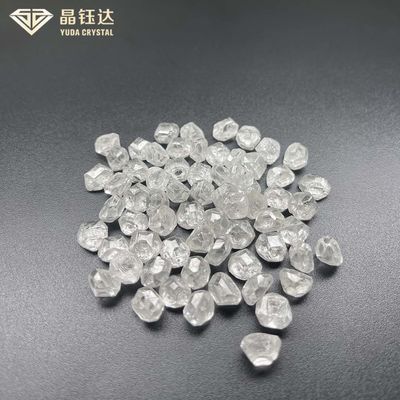DE Color VS Clarity Rough Lab Grown Diamonds Made By HPHT Method
Rough Lab Grown Diamonds Description
Lab-grown diamonds are real diamonds.
There are two ways to create rough lab-grown diamonds. They are HPHT and CVD methods.
The HPHT method is a more traditional diamond cultivation method that uses molten metal alloys such as iron (Fe), nickel (Ni) or cobalt (Co) to form diamonds.
The HPHT diamond process takes place in a small capsule in a device with ultra-high pressure. In this capsule, the diamond powder is dissolved in the molten metal solvent, and then begins to crystallize to form diamond crystals. The entire crystallization process will take weeks. At a time, one or more crystals are produced.
Except for the octahedral body, the diamond crystals grown using HPHT technology are usually cubic crystals. Since natural diamonds and HPHT synthetic diamonds have different crystal shapes, and their internal growth structures are also very different, we can distinguish between natural diamonds and HPHT synthetic diamonds through these two points.
In addition, HTHP synthetic diamonds usually have certain visual characteristics, such as color distribution, fluorescence partition, grain structure, and metal inclusions.
In order to cultivate colorless HPHT diamonds, apart from the need to isolate nitrogen during the cultivation process, the cultivation of high-purity colorless diamonds (type IIa or type IIb) often requires a longer cultivation period and stricter temperature and pressure conditions. As a result, the cultivation cycle is longer than that of type Ib synthetic diamonds, so how to use HPHT synthesis to grow large-grain crystals has always been a problem. However, with the development of technology, it is now possible to use HPHT synthesis to grow more than 10 carats diamond crystals too.
In the process of HPHT diamond cultivation, you can also add chemical elements or radiant heating to make the crystal appear blue or red, but this practice is not common.
Parameters of Rough Lab Grown Diamonds
| Rough Lab Grown Diamonds Details |
| Brand Name |
Yuda Crystal |
| Name |
Rough Lab Grown Diamonds |
| Diamond Color |
D-F |
| Diamond Clarity |
VVS VS SI |
| Diamond Carat Weight |
0.03ct -20ct |
| Diamond Cut |
Uncut |
| Technology |
HPHT |
| Size |
1.0-20.0mm |
| Shape |
Raw |
| Application |
For Cutting Lab Grown Loose Diamonds |
| Place Of Origin |
Zhengzhou, China |
| Delivery Time |
1 - 15 Working Days Base on Order Quantity |
| Payment Terms |
100% Payment In Advance |
| Payment Methods |
T/T, PayPal, Western Union, Bank Transfer |
| Shipping way |
DHL, FedEx, SF Express, UPS, EMS, TNT etc |
| M.O.Q |
Negotiable |
| Diamond Type |
Synthetic(lab created) |
| Location |
Zhengzhou, China |
| Treatments Applied |
None |
| Fire Dispersion |
0.044(Same as Natural Diamond) |
| Brilliance Refraction Index |
2.42(Same as Natural Diamond) |
| Relative Density |
3.52(Same as Natural Diamond) |
| Chemical Composition |
Carbon(Same as Natural Diamond) |
| Moh's Hardness |
10(Same as Natural Diamond) |
Lab Grown Diamonds Introduction
Natural diamonds are created by nature and are the result of high temperature and high pressure formed over billions of years. The Lab Grown Diamonds are produced in the laboratory, usually in a few weeks. The chemical composition between the two is same.
So how do you distinguish between Lab Grown Diamonds and natural diamonds?
There is no obvious difference between the Lab Grown Diamonds and natural diamonds. Even professional gemologists need special equipment to identify them. Professionals will be able to discern subtle contrasts in diamond inclusions grown and mined in the laboratory.
| The Difference Between Lab Diamond And Natural Diamond |
| Properties |
Earth Mined |
Lab Created |
| Guaranteed Conflict-Free |
No |
Yes |
| Hardness (MOHS) |
10 |
10 |
| SP3 Carbon Diamond Bonds (%) |
100% |
100% |
| Internal Crystal Structure |
Face-Centered Cubic |
Face-Centered Cubic |
| Hardness Comparable |
2.42 |
2.42 |
| Relative Diversity |
3.52 |
3.52 |
| Color Diffusion |
0.044 |
0.044 |
| Color |
Various Grades |
K to D grades |
| Price |
$$$$$ |
$$$ |
Rough Lab Grown Diamonds Details


 Your message must be between 20-3,000 characters!
Your message must be between 20-3,000 characters! Please check your E-mail!
Please check your E-mail!  Your message must be between 20-3,000 characters!
Your message must be between 20-3,000 characters! Please check your E-mail!
Please check your E-mail! 






